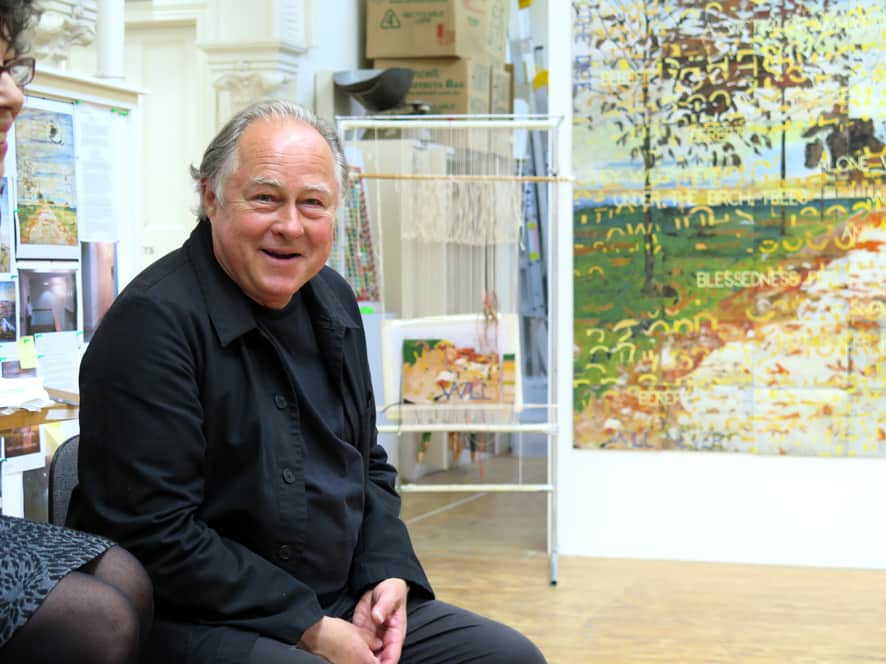




Imants Tillers designed Avenue of Remembrance to coincide with the centenary commemorations of Gallipoli. It was unveiled at the Australian War Memorial (AWM) in Canberra in 2015.
Director of the AWM Dr Brendan Nelson said that the tapestry would “highlight the scale and grandeur of this imposing artwork, as well as commentating on the commitment of Australia’s service men and women over more than 100 years”. The tapestry was commissioned by the Australian War Memorial, through a very generous donation by the Geoff and Helen Handbury Foundation.
Tillers’ drew his inspiration for the design in-part from The Gallipoli letter—an 8000 word document written by Keith Murdoch during the early part of World War 1, remarking that:
"The letter is justifiably considered to be one of the National Library’s most important objects and the content of the letter is regarded as having helped bring an end to the Gallipoli campaign. In this letter Murdoch laments, “how young Australians, knowing that they would probably die were flocking to fight on Gallipoli’s “sacred soil’”.
The passionate and urgent tone of Murdoch’s letter and sometimes, even his turn of phase (“congealed incompetency”), immediately struck a chord with me when I first read it. Also by coincidence, it seemed to me, that I had already been using similar expressions in many of my works over the last decade: “There’s not a shred of hope”; “Stupefied by circumstance”; “The appalling silence”; “Purified by tears”; “A victim of what is infinitely close at hand”; to name a few. These were paintings reflecting on mortality, being, time, loss, grieving and remembrance, perhaps prompted by the death of my parents and several close friends in the passing decade. Typically these paintings combined image and text into a kind of visual spatial poem and I decided to use a similar approach for this project … I decided to eschew an exclusive focus on the tragic but national-defining event that was Gallipoli: (and its geography and topography) and to make reference to the whole of the Australian participation in World War 1.
The names of places where Australians were buried (rather than the actual theatres of war) are quoted as readymade poetic elements in my design. Thus familiar names such as ‘Anzac Cove’, ‘Shrapnel Valley’, ‘Lone Pine’, appear alongside other Middle Eastern locales: ‘Jerusalem’, ‘Gaza’, ‘Beirut’ and ‘El Alamein’. But the majority of the resting places of our war dead are European and less familiar French and Belgian places on what was called the Western Front: ‘Ypres’, ‘Polygon Wood’, ‘Poperinghe’, ‘Zonnebuke’, ‘Fromelles’, ‘Villers-Bretonneau’, ‘Peronne’, ‘Fleurbaix’ to name just a few.
In many places in the world including Australia there are ‘gardens of remembrance’ – beautiful, serene places commemorating the dead, especially those killed in the wars of 1914-18 and 1939-45. There are also ‘avenues of remembrance’ where each tree planted commemorates a particular, unique individual who died in action. These are beautiful, sad and redemptive places.
We all know that an ‘avenue’ is not only a regular planting of trees along a road, it is also more abstractly ‘a way to access or approach’ something – to an idea or even a memory. My ‘Avenue of Remembrance’ is, I hope, a way or means to remember not only those young men who died but also the profound loss and grief experienced by their mothers, their fathers, their brothers and sisters. By their friends, by their communities. By our nation."
Imants Tilles is represented by Arc One Gallery, Melbourne, Roslyn Oxley9 Gallery, Sydney, GAGPROJECTS, Adelaide and Bett Gallery, Hobart.